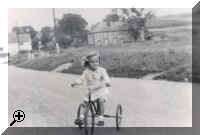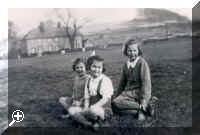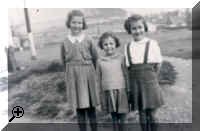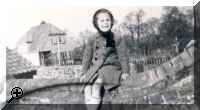Schooldays at Moulton Primary - 1942 to 1948
 I
believe I began school at the age of four and a half which, since I was born in
July 1937, would probably have been after the Christmas holidays in 1942. This
is strange as the picture conjured up is one of sunny days and light summer
dresses, tripping across the village green, over the little bridge and along
Brookside. But then childhood is mostly remembered in warm sunny weather with
the occasional contrast of snow, snowball fights, and fun with sleighs; seldom
cold grey wet days of which I am sure there must have been many.
I
believe I began school at the age of four and a half which, since I was born in
July 1937, would probably have been after the Christmas holidays in 1942. This
is strange as the picture conjured up is one of sunny days and light summer
dresses, tripping across the village green, over the little bridge and along
Brookside. But then childhood is mostly remembered in warm sunny weather with
the occasional contrast of snow, snowball fights, and fun with sleighs; seldom
cold grey wet days of which I am sure there must have been many.
 I
don't remember ever being taken to school. I would join up with Robin (my best
friend) and her sister Beryl, who lived just across the road in the house
adjoining their mother's grocery shop (now the . There was little or no traffic
and we would know everyone we met. Later I would run through the brook to Vera
James's house, the pathway in the dry riverbed evidencing its constant
use.
I
don't remember ever being taken to school. I would join up with Robin (my best
friend) and her sister Beryl, who lived just across the road in the house
adjoining their mother's grocery shop (now the . There was little or no traffic
and we would know everyone we met. Later I would run through the brook to Vera
James's house, the pathway in the dry riverbed evidencing its constant
use.
 School
was, of course, the large flint building by the brook, and was a church school.
In 1942 all the village children went there until age 15 unless they passed a
scholarship to the Grammar School in Newmarket or elsewhere, or made other
private arrangements. In those days the Rectory was the only house at the end of
the long drive alongside the school and the vicar was Reverend Brerton, replaced
in about 1945 or 6 by Reverend Hood.
School
was, of course, the large flint building by the brook, and was a church school.
In 1942 all the village children went there until age 15 unless they passed a
scholarship to the Grammar School in Newmarket or elsewhere, or made other
private arrangements. In those days the Rectory was the only house at the end of
the long drive alongside the school and the vicar was Reverend Brerton, replaced
in about 1945 or 6 by Reverend Hood.
The entrance to the school was through quite impressive iron gates, one large
which was seldom opened and a smaller one in constant use. Iron railings ran all
the way along the aforementioned drive. During the war most iron railings and
gates were taken away to make much of the machinery necessary for the war
effort, but I don't remember "ours" being taken - only the fear that
they might. On the left on entering, a hedge separated the school area from the
headmistress's garden and in front of the hedge was a large wooden notice board
almost bare of its dry curling black paint. No doubt many interesting notices
were posted there from time to time, but in my mind's eye I see only two:
pictures of the colorado beetles which we were invited to look out for so that
they could be annihilated before they devastated the potato crops, and the rose
hips which we were asked to pick. These went I know not where, but were to make
rosehip syrup, a supplement to the diet in case of lack of vitamin C. There were
plenty of dog roses on the other side of the brook from the school so collecting
the hips in the autumn was no problem. However, I never remember anyone finding
a colorado beetle.
The
school itself comprised simply the "big room" and the "little
room" with an entrance where the coats were hung. The latter was simply of
painted brick walls with a concrete floor and lines of pegs, low ones for the
little ones and higher ones for the bigger ones. The "big ones" when I
first started school seemed so very big and awesome: I think I can remember the
Tweed boys, John and Don and the Wright boys Bill, Jack and Ted and Ken Turner,
but there were obviously others, and the girls would have been perhaps the Mason
girls Audrey and Betty, Iris and Freda Jennings. In this lobby the boys played a
"game" throwing hats so high that they could be made to lodge on the
ledge where the wall met the ceiling, well out of reach of the poor unfortunate
owner who would have to go home hatless or find a means of retrieving it.
However, I think it could only have been shortly after I joined the school that
the Secondary Modern, as it was then called, was built in Newmarket and no-one
remained at Moulton School after the age of 11.
 I loved my early school days. The "little room" was half filled
with a miscellany of desks in a range of sizes facing away from the playground:
small tables and chairs for the very smallest, long larger desks some seating
four with benches attached, and some even more "grown up ones" on the
left wall. That is to say, the left wall to Miss Poulter the infant teacher
(later Mrs. Philip Tweed) who faced the class from her high desk and high stool
on that side of the classroom. On Miss Poulter's right was a large cupboard
stretching almost to the ceiling, with little circular holes in the doors. I
often wondered what the holes were for: I can appreciate now that they would
certainly have been useful had anyone been unfortunate enough to be shut in.
This cupboard was magic. It contained all sorts of books, crayons, coloured
pencils, paints and many other delights such as we were not used to having at
home as the war had by this time been waging for two years and such things were
already in short supply. No doubt the ones in the cupboard were also becoming
rather old and worn, but never mind, they brightened up our days and I always
felt that the huge cupboard held just one more desirable object which was yet to
be enjoyed.
I loved my early school days. The "little room" was half filled
with a miscellany of desks in a range of sizes facing away from the playground:
small tables and chairs for the very smallest, long larger desks some seating
four with benches attached, and some even more "grown up ones" on the
left wall. That is to say, the left wall to Miss Poulter the infant teacher
(later Mrs. Philip Tweed) who faced the class from her high desk and high stool
on that side of the classroom. On Miss Poulter's right was a large cupboard
stretching almost to the ceiling, with little circular holes in the doors. I
often wondered what the holes were for: I can appreciate now that they would
certainly have been useful had anyone been unfortunate enough to be shut in.
This cupboard was magic. It contained all sorts of books, crayons, coloured
pencils, paints and many other delights such as we were not used to having at
home as the war had by this time been waging for two years and such things were
already in short supply. No doubt the ones in the cupboard were also becoming
rather old and worn, but never mind, they brightened up our days and I always
felt that the huge cupboard held just one more desirable object which was yet to
be enjoyed.
There were two other enchantments in the room: the rocking horse and the box
under Miss Poulter's desk. Today the latter seems very mundane as it contained
only wooden blocks which were not even coloured, but they were brought out only
very occasionally and I held them to be a great treat. I wonder where the
rocking horse is now; it would probably be prized in the Antiques Road Show.
Behind Miss Poulter's desk was a black stove which had to be stoked with coke
and which warmed the room in winter. There was a similar stove in the big room.
Crates of milk were delivered daily for all the children, initially I believe
one third of a pint for each child for the morning and afternoon breaks. As far
as I was concerned cold milk was just about OK, but when in the winter all the
bottles were tipped into one huge pot and the milk warmed on the stove
throughout the course of the morning forming a thick layer of skin, the very
idea made me heave. However, this was overcome by bringing in small jars of
ovaltine or drinking chocolate which, skin apart, made the milk just about
palatable. You will see that the government was keen that we children should not
be deprived of essential foods during the war. We were also given (I believe it
was free though we didn't actually take it at school) cod liver oil and malt.
This came in "tins" but only the top and bottom were of metal, the
cylindrical part being of cardboard. However, the contents were very tasty as
the malt and the sweetness completely disguised the taste of the cod liver oil.
It was like being asked to eat sweets from a spoon.
But to return to Miss Poulter, you will no doubt have noticed I don't speak
much about learning. This is probably because I enjoyed school so much that that
part of it was merely an extension of play. It would perhaps be going too far to
say that Miss Poulter was my idol, but I always wanted to be a primary school
teacher like Miss Poulter, and still wish I had been.
The "big room" was a slightly different kettle of fish. Mrs.
Fritchley was the headmistress and very strict. Not that I ever remember being
upset or unhappy or chastised in any way. There was a cane and I suppose it must
have been used, but I don't remember any such occasion. Maybe there were one or
two whacks over the knuckles with the ruler. It must have been very difficult to
teach children from the age of 8 to 11 all at the same time and all in the same
room. I cannot remember the size of the class but there were four or five (front
to back) rows each contining about four desks. The younger ones were on Mrs.
Fritchley's right and the older children on her left. I did not of course
experience the time when she had children up to the age of 15 in her class. The
surprising thing about my particular year was that there was seven of us: the
Jennings twins Anita and Audrey, Louis Daines, Annabelle Vincent, Vera James,
myself and one boy, Peter Burling, Then we became eight when Pamela Starvis
joined the school. The year ahead of us there were only three: Dawn Betts, Olive
Wright and Keith Tate, and ahead of them again only three: Robin Jennings, Brian
Turner and Jim Mason.
Mrs. Fritchley was in fact quite a character. Although she was strict she was
a very good teacher, but to our young eyes old-fashioned and perhaps a little
eccentric. She was quite a large lady and wore dresses which would have dipped
alarmingly in her cleavage had she not worn a "frontispiece". I am
sure this is not the right word for it being a title page in a book, or pediment
over a door, but the word somehow fits. It consisted of a piece of material,
usually lacey, about five or six inches square, which was fixed into the dress
with small gold safety-pins. She also had a huge collection of lisle stockings.
We knew this because this is how we all learned to darn. I am sure there were
not better darners in the whole country. These were the days of "make do
and mend" with mushrooms and darning wool a-plenty. The mushroom was pushed
into the garment so that the offending hole was central over its smooth surface
and the lines of wool sewn so that a little loop was left at each turn from the
holes edges to allow the repair to "give". Then of course the mushroom
was turned through 90 degrees and the sewing wool meticulously woven over and
under the original strands thus eventually filling the hole. I am sure no-one
over the age of 40 needs to be told how to darn, but my guess is that very
little of it goes on today.
Many jokes were made about Mrs. Fritchley's basket of stockings, indeed often
stretching to her bloomers and other garments, and in this basket we also found
Percy's socks. This was Mr. Fritchley, whose existence was something of an
enigma to us children. If he was in Moulton it was usually only at weekends and
we therefore did not see him, and he (they?) apparently also had a house in
Jaywick where Mrs. F. would sometimes go for weekends and where we assumed Mr.
F. was at other times.
But I digress. We did also learn to knit and quite often it was dishcloths.
Even Peter Burling knitted dishcloths, and he had needles bigger than any of us,
which was probably just as well because he was a big chap. We made raffia mats
too: circles of cardboard with string wound from the central hole round the
teeth on the outside edges and the resulting "spokes" then woven with
the rafia from the centre outwards. The prosaic nature of these lessons was no
doubt largely due to the lack of resources. At Christmas time we made streamers
by sticking coloured strips of paper into circles which were looped together
into a chain. If, like me, you had only been 2 when the war started and knew
nothing more exotic, then this was quite exciting. There were no such things a
birosand all writing was done with lead pencils (very precious) or pens with
nibs which were dipped into the inkwells dropped into the inkwell holes in each
desk. We had monitors who were responsible for filling the inkwells, rubbing the
blackboard clean, replenishing the chalk and other small tasks. We probably used
a lot of blotting paper as the ink was such a messy business. We had reading
books of course, and we had sufficient exercise books for our purposes and
copying books with copperplate examples, but great care was always taken of the
school property. Then there were the tables. We recited these parrot fashion -
but we knew them and how they worked, as well as the avoirdupois and the feet
and inches: did you know that one rood was equal to 40 perches? We had got as
far as long division, fractions and decimals by the time we took our 11+. I
loved dictation and trying not to make a spelling mistake; and composition too.
Sometimes we used to sing. Miss Poulter would come into the big room and play
the piano and we sang songs like The Grand Old Duke of York, Clementine and
Hearts of Oak (did we or was this at home?). I once learned a beautiful poem, to
be recited very slowly, which I think must have been at Moulton Primary: "I
will make you a little house, with a roof of thatch and a window as clear as
crystal dew and a door with a knocker of pearl, and a silver dream for a latch.
And high on the shining wall of the house shall be a bird of joy in an ivory
cage to sing. Never a sorrow shall enter, and never a pain, never the sorrowful
cry of the wind shall fret, or your heart be sad, or your eyes be dim again.
Sleep, oh my heart of gold, sleep and forget." I'm not sure if I have it
all and it would seem to be a lullaby to a child who has been ill, but I can't
think I learned it anywhere other than at Moulton School.
I remember learning about the Angles and Saxons in History, and the
rudimentary equipment used by the ancient Egyptians to irrigate their land from
the Nile. Once, when learning about the war, we had a picture to colour of
soldiers learning how to use parachutes.
The war didn't impinge much on our lives. We practised diving under our desks
when we heard the siren and of course knew full well which was the warning and
which the "all-clear". We all had gas masks in a box with a strap so
that it could be carried over the shoulder. Mine was a Mickey Mouse one; I'm not
sure how old you had to be to have outgrown such amusements. Every so often
Wilfred Jennings would come to the school to test the gas masks to ensure that
they would still work properly in the event that we were all about to be gassed.
(? building of an Anderson shelter in the playground)
Despite being a church school I learned a lot more of the bible from the
Methodist Sunday School than the village school, but I do remember learning the
Ten Commandments and having to recite the catechism. The little book said: Q.
What is your name? A. My name is N... Q Who gave you this name? A. My
godfather(s) and godmother(s)..................and that's as much as I remember.
However, we all knew what Ash Wednesday meant: we all went to church first thing
in the morning, and then had the rest of the day off. Reverend Brerton and
Reverend Hood did come into the school from time to time but I don't think it
was a frequent occurence. I recall Reverend Hood saying to me once (it may not
have been at school) that I had a strange combination of names: Diana the
goddess of the chase and Mary the virgin. The significance passed me by at the
time.
There were times when the boys did some gardening, both, I think, in the
patch alongside the drive up to the Rectory and also an area near what is now
John Gunsons's land. The Dr. Barnado's boys may have come into this somehow.
They had been evacuated (presumably from London) and had there own school in the
Village Hall, or village hut as it was called because that is what it was - a
large wooden hut. They were billeted in accommodation at Warren Towers or Warren
Place and had to walk the three miles (would it be?) morning and evening in
crocodile. Their teacher was a Mr. Drury who lodged with us in the pub. during
this period. Somehow I think one or two boys remained when the body of them left
Warren Towers, and came to our school as I vaguely remember a John Hunt. It is
the all grey uniform that sticks in my mind. Moulton Primary at that time had no
uniform. As far as the gardening was concerned, the most vivid picture I have of
the land along the Rectory drive is of huge sunflowers, although I think these
were in fact planted by the Jennings family who then lived in Priory Cottage. On
reflection, it seems as if the sunflowers were always there, but I guess it was
probably only for two seasons, or three at most.
Of course the playground played (no pun intended) an important part in our
school lives. I remember grandmother's footsteps where one person stood with her
face to the wall and the others would creep up behind her from the railings.
Every so often she would turn round suddenly and if she caught anyone moving so
much as a muscle they had to go back to the railings. Then there was Ring a Ring
of Roses and The Farmer's in his Den, Here we go round the Mulberry Bush and
Oranges and Lemons; lots of skipping games and ball games - mostly two ball up
against a flat wall if you could find one, leapfrogging and the like. I vaguely
remember the playground at one time being divided vertically from top to bottom
to separate the smaller children from the larger one (or was it the boys from
the girls?) and then the fence being altered so that it was divided
horizontally. One of my favourite pastimes then was to do a handstand up against
the fence so that my knees wrapped over the top and I could pull myself up to
sit on the fence.
The toilets were at the far top left of the playground. They were of the
hole-in-the-wood with a bucket underneath type - at least the girls' were. I
never dared venture round to the boys' side of the fence. As there were only
three we often had to queue as we came out at playtime and I recall a cold
winter's day when we were admonished for the noise we made as we exaggerated our
teeth chattering and moaned with it. Funny how things stick in your mind. There
were two of the three Brent sisters involved, Pat and Evelyn and I can see them
now in their wine coloured dresses. They left the village shortly after that,
but I don't think there was any connection.
I am unhappy now at how little I do recall clearly of what actually happened.
For example, I imagine we did PT or some kind of drill and exercises in the
playground, but I cannot visualise it. There was an extra room built between the
exit from the back of the big room and the entrance into Mrs. Fritchley's house.
This enabled her to go from the school to her home without going outside, but
the room itself was called a kitchen. Did we have school dinners delivered
there, and if we did where did we eat them? Maybe someone else can remember.
Mrs. Fritchley left the school one year before I did and so Mrs. Brown was my
teacher for the year 1947/8. Miss Poulter had already been replaced by Mrs.
..............Then of course in the school was sold as the new one had been
built
Diane Green